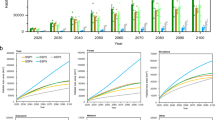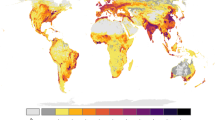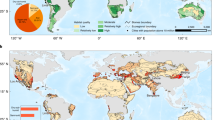Abstract
The escalating trend of global hillside urban expansion threatens terrestrial biodiversity and undermines global initiatives, including the Sustainable Development Goals and the Global Biodiversity Framework. This study addresses a critical knowledge gap by examining the impacts of hillside urban expansion on terrestrial biodiversity across multiple scales, integrating multi-source high-resolution data with terrestrial vertebrate species datasets. Our results reveal substantial global hillside urban expansion (11.65 Mha) between 2000 and 2020, with 35% occurring within biodiversity hotspots. It encroaches disproportionately on natural habitat compared to urban expansion in flat areas, significantly exacerbating habitat fragmentation. This has far-reaching consequences for terrestrial biodiversity, directly affecting ~70% of globally threatened species and hindering progress towards biodiversity conservation by 2050. Our findings underscore an urgent need for tailored land-use and urban planning strategies that prioritize biodiversity conservation in ecologically sensitive areas. This study lays the groundwork for the development of more sustainable land-use planning, nature conservation and urban development policies.
This is a preview of subscription content, access via your institution
Access options
Subscribe to this journal
Receive 12 digital issues and online access to articles
$119.00 per year
only $9.92 per issue
Buy this article
- Purchase on SpringerLink
- Instant access to full article PDF
Prices may be subject to local taxes which are calculated during checkout





Similar content being viewed by others
Data availability
All underlying model data are publicly accessible online. The global basic landform unit data can be obtained via Earth System Science Data at https://doi.org/10.5194/essd-2024-401 (ref. 42). The GlobeLand30 data (2000 and 2020) are available at https://www.un-spider.org/links-and-resources/. The GAIA map (2000 and 2020) is available at https://data-starcloud.pcl.ac.cn/iearthdata/13 (ref. 45). The GISA2.0 map (2000 and 2019) is available via Zenodo at https://zenodo.org/record/5136330 (ref. 46). The GISD30 map (2000 and 2020) is available via Zenodo at https://zenodo.org/records/5220816 (ref. 47). Expert-derived polygons of species are available online via the IUCN Red List Portal at https://www.iucnredlist.org/resources/spatial-data-download. GIS country boundaries from Natural Earth are available at https://www.naturalearthdata.com/downloads. The biodiversity hotspot data can be retrieved from https://databasin.org. The future urban expansion dataset based on the five shared socioeconomic pathways is available via Pangaea at https://doi.pangaea.de/10.1594/PANGAEA.905890. Source data are provided via Zenodo at https://doi.org/10.5281/zenodo.15034804 (ref. 49).
Code availability
The code that supports our findings is available via Github at https://github.com/wwwyizhen/HUE.
References
Frolking, S., Mahtta, R., Milliman, T., Esch, T. & Seto, K. C. Global urban structural growth shows a profound shift from spreading out to building up. Nat. Cities 1, 555–566 (2024).
Lewin, A., Murali, G., Rachmilevitch, S. & Roll, U. Global evaluation of current and future threats to drylands and their vertebrate biodiversity. Nat. Ecol. Evol. 8, 1448–1458 (2024).
Foley, J. A. et al. Global consequences of land use. Science 309, 570–574 (2005).
Yang, C. et al. Human expansion into Asian highlands in the 21st century and its effects. Nat. Commun. 13, 4955 (2022).
Menzori, I. D., de Sousa, I. C. N. & Gonçalves, L. M. Local government shift and national housing program: spatial repercussions on urban growth. Land Use Policy 126, 106548 (2023).
Shi, K., Yu, B., Ma, J., Cao, W. & Cui, Y. Impacts of slope climbing of urban expansion on global sustainable development. Innovation 4, 100529 (2023).
Yang, C. et al. Human expansion-induced biodiversity crisis over Asia from 2000 to 2020. Research 6, 0226 (2023).
Feng, Y. et al. Upward expansion and acceleration of forest clearance in the mountains of Southeast Asia. Nat. Sustain. 4, 892–899 (2021).
Chen, T.-H. K., Pandey, B. & Seto, K. C. Detecting subpixel human settlements in mountains using deep learning: a case of the Hindu Kush Himalaya 1990–2020. Remote Sens. Environ. 294, 113625 (2023).
Ozturk, U. et al. How climate change and unplanned urban sprawl bring more landslides. Nature 608, 262–265 (2022).
Kuipers, K. J. et al. Habitat fragmentation amplifies threats from habitat loss to mammal diversity across the world’s terrestrial ecoregions. One Earth 4, 1505–1513 (2021).
Yang, C. et al. Comparing hillside urbanizations of Beijing–Tianjin–Hebei, Yangtze River Delta and Guangdong–Hong Kong–Macau greater bay area urban agglomerations in China. Int. J. Appl. Earth Obs. Geoinf. 102, 102460 (2021).
Seto, K. C., Güneralp, B. & Hutyra, L. R. Global forecasts of urban expansion to 2030 and direct impacts on biodiversity and carbon pools. Proc. Natl Acad. Sci. USA 109, 16083–16088 (2012).
Ma, J., Li, J., Wu, W. & Liu, J. Global forest fragmentation change from 2000 to 2020. Nat. Commun. 14, 3752 (2023).
McDonald, R. I. et al. Research gaps in knowledge of the impact of urban growth on biodiversity. Nat. Sustain. 3, 16–24 (2020).
Simkin, R. D., Seto, K. C., McDonald, R. I. & Jetz, W. Biodiversity impacts and conservation implications of urban land expansion projected to 2050. Proc. Natl Acad. Sci. USA 119, e2117297119 (2022).
Wiedmann, T. & Allen, C. City footprints and SDGs provide untapped potential for assessing city sustainability. Nat. Commun. 12, 3758 (2021).
Xu, Z. et al. Assessing progress towards sustainable development over space and time. Nature 577, 74–78 (2020).
Bai, X. et al. Six research priorities for cities and climate change. Nature 555, 23–25 (2018).
Meng, Z. et al. Post-2020 biodiversity framework challenged by cropland expansion in protected areas. Nat. Sustain. 6, 758–768 (2023).
Soares, R. M. V., Lira, P. K., Manes, S. & Vale, M. M. A methodological framework for prioritizing habitat patches in urban ecosystems based on landscape functional connectivity. Urban Ecosyst. 27, 147–157 (2024).
van Vliet, J. Direct and indirect loss of natural area from urban expansion. Nat. Sustain. 2, 755–763 (2019).
Shi, K. et al. Satellite remote sensing data reveal increased slope climbing of urban land expansion worldwide. Landscape Urban Plann. 235, 104755 (2023).
Tollefson, J. Why deforestation and extinctions make pandemics more likely. Nature 584, 175–177 (2020).
Shi, K., Wu, Y. & Liu, S. Slope climbing of urban expansion worldwide: spatiotemporal characteristics, driving factors and implications for food security. J. Environ. Manage. 324, 116337 (2022).
Chang, Z. et al. Hillside urban expansion exacerbates nature and semi-nature habitat landscape fragmentation in China. Int. J. Digital Earth 17, 2368095 (2024).
Yang, C. et al. Characteristics and trends of hillside urbanization in China from 2007 to 2017. Habitat Int. 120, 102502 (2022).
Brook, B. W., Sodhi, N. S. & Ng, P. K. L. Catastrophic extinctions follow deforestation in Singapore. Nature 424, 420–423 (2003).
Rimal, B. et al. Effects of land use and land cover change on ecosystem services in the Koshi River Basin, Eastern Nepal. Ecosyst. Serv. 38, 100963 (2019).
Piana, P., Brocada, L., Hearn, R. & Mangano, S. Urban rewilding: human–wildlife relations in Genoa, NW Italy. Cities 144, 104660 (2024).
Ren, Q. et al. Impacts of global urban expansion on natural habitats undermine the 2050 vision for biodiversity. Resour. Conserv. Recycl. 190, 106834 (2023).
Gao, L. & Bryan, B. A. Finding pathways to national-scale land-sector sustainability. Nature 544, 217–222 (2017).
Zhou, L., Dang, X., Mu, H., Wang, B. & Wang, S. Cities are going uphill: slope gradient analysis of urban expansion and its driving factors in China. Sci. Total Environ. 775, 145836 (2021).
Elsen, P. R., Monahan, W. B. & Merenlender, A. M. Topography and human pressure in mountain ranges alter expected species responses to climate change. Nat. Commun. 11, 1974 (2020).
Li, G. et al. Global impacts of future urban expansion on terrestrial vertebrate diversity. Nat. Commun. 13, 1628 (2022).
Laurance, W. F. & Engert, J. Sprawling cities are rapidly encroaching on Earth’s biodiversity. Proc. Natl Acad. Sci. USA 119, e2202244119 (2022).
McDonald, R. I., Güneralp, B., Huang, C.-W., Seto, K. C. & You, M. Conservation priorities to protect vertebrate endemics from global urban expansion. Biol. Conserv. 224, 290–299 (2018).
The IUCN Red List of Threatened Species ver. 2017‐3 (IUCN, 2017); https://www.iucnredlist.org
Li, Z. et al. SinoLC-1: the first 1 m resolution national-scale land-cover map of China created with a deep learning framework and open-access data. Earth Syst. Sci. Data 15, 4749–4780 (2023).
Jones, K. R. et al. One-third of global protected land is under intense human pressure. Science 360, 788–791 (2018).
Zhao, J. et al. Future global conflict risk hotspots between biodiversity conservation and food security: 10 countries and 7 biodiversity hotspots. Glob. Ecol. Conserv. 34, e02036 (2022).
Yang, X. et al. Global basic landform units derived from multi-source digital elevation models at 1 arc-second resolution. Preprint at Earth Syst. Sci. Data https://doi.org/10.5194/essd-2024-401 (2024).
He, C., Liu, Z., Tian, J. & Ma, Q. Urban expansion dynamics and natural habitat loss in China: a multiscale landscape perspective. Glob. Change Biol. 20, 2886–2902 (2014).
Leclère, D. et al. Bending the curve of terrestrial biodiversity needs an integrated strategy. Nature 585, 551–556 (2020).
Gong, P. et al. Annual maps of global artificial impervious area (GAIA) between 1985 and 2018. Remote Sens. Environ. 236, 111510 (2020).
Huang, X. et al. Toward accurate mapping of 30-m time-series global impervious surface area (GISA). Int. J. Appl. Earth Obs. Geoinf. 109, 102787 (2022).
Zhang, X. et al. GISD30: global 30 m impervious-surface dynamic dataset from 1985 to 2020 using time-series Landsat imagery on the Google Earth Engine platform. Earth Syst. Sci. Data 14, 1831–1856 (2022).
Fischer, R. et al. Accelerated forest fragmentation leads to critical increase in tropical forest edge area. Sci. Adv. 7, eabg7012 (2021).
Shi, K. et al. Extensive terrestrial biodiversity threats from global hillside urban expansion. Zenodo https://doi.org/10.5281/zenodo.15034804 (2025).
Acknowledgements
K.S. acknowledges the support of the National Natural Science Foundation of China (number 42101345) and the Natural Science Research Program of Anhui Universities (number 2023AH020029). B.Y. acknowledges support from the National Natural Science Foundation of China (number 42371332).
Author information
Authors and Affiliations
Contributions
Conceptualization: K.S., Y.W., L.G., C.H., B.Y. and B.A.B. Data curation: K.S., Y.W., X.S., Y.C., L.S., Y.C. and Z.C. Methodology: K.S., Y.W., L.G. and B.A.B. Investigation: Z.C., F.F., W.C., L.S., J.M. and C.H. Visualization: K.S., Y.W. and C.H. Funding acquisition: K.S. and B.Y. Writing—original draft: K.S. and Y.W. Writing—review and editing: all authors.
Corresponding authors
Ethics declarations
Competing interests
The authors declare no competing interests.
Peer review
Peer review information
Nature Cities thanks thanks Antonio T. Monteiro, Chao Yang and the other, anonymous, reviewer(s) for their contribution to the peer review of this work.
Additional information
Publisher’s note Springer Nature remains neutral with regard to jurisdictional claims in published maps and institutional affiliations.
Extended data
Extended Data Fig. 1 Spatial distributions of hillside urban expansion globally within 3-km× 3-km grid cells.
a, Hillside urban expansion area; b, Hillside urbanization rate. Maps created with QGIS software. Administrative boundary data from Natural Earth (https://www.naturalearthdata.com).
Extended Data Fig. 2 Heatmap of habitat loss in hillside regions globally within 3-km× 3-km grid cells.
Maps created with QGIS software. Administrative boundary data from Natural Earth (https://www.naturalearthdata.com).
Extended Data Fig. 3 Changes of hillside habitat fragmentation globally within 3-km× 3-km grid cells.
Mean patch size of hillside habitats in a, 2000, and b, 2020. c, Trends in habitat fragmentation from 2000-2020. Note: Grid cells without hillside urbanization are ignored. A higher MPS value indicates greater patch connectivity and a more intact ecosystem, while a lower value suggests severe landscape fragmentation, which may threaten species habitats. Maps created with QGIS software. Administrative boundary data from Natural Earth (https://www.naturalearthdata.com).
Extended Data Fig. 4 Attainment of biodiversity conservation by 2030 and 2050.
The total number of countries (upper panel) and biodiversity hotspots (lower panel) that can meet the target under at least one scenario.
Extended Data Fig. 5 Effects of habitat landscape changes (habitat loss and habitat fragmentation) on threatened species at the national scale.
Trends in plain urban expansion (a, in countries and b, in biodiversity hotspots) and hillside urban expansion (c, in countries and d, in biodiversity hotspots).
Extended Data Fig. 6 Effects of habitat landscape changes (habitat loss and habitat fragmentation) on threatened species on the biodiversity hotspots scale.
Trends in plain urban expansion (a, in countries and b, in biodiversity hotspots) and hillside urban expansion (c, in countries and d, in biodiversity hotspots).
Extended Data Fig. 7 Validation sites of global hillside and plain urban expansion.
a, Global distribution of all validation sites. b–e, Information of selected validation points. Administrative boundary data from Natural Earth (https://www.naturalearthdata.com). Panels b–e: map data in the top three rows from Google Earth.
Supplementary information
Supplementary Information
Supplementary Notes 1–3, Figs. 1–18 and Tables 1–7.
Source data
Source Data Fig. 2
Statistical source data.
Source Data Fig. 3
Statistical source data.
Source Data Fig. 4
Statistical source data.
Source Data Fig. 5
Statistical source data.
Source Data Extended Data Fig. 4
Statistical source data.
Source Data Extended Data Fig. 5
Statistical source data.
Source Data Extended Data Fig. 6
Statistical source data.
Source Data Extended Data Fig. 7
Statistical source data.
Rights and permissions
Springer Nature or its licensor (e.g. a society or other partner) holds exclusive rights to this article under a publishing agreement with the author(s) or other rightsholder(s); author self-archiving of the accepted manuscript version of this article is solely governed by the terms of such publishing agreement and applicable law.
About this article
Cite this article
Shi, K., Wu, Y., Sun, X. et al. Extensive terrestrial biodiversity threats from global hillside urban expansion. Nat Cities (2025). https://doi.org/10.1038/s44284-025-00316-9
Received:
Accepted:
Published:
DOI: https://doi.org/10.1038/s44284-025-00316-9



